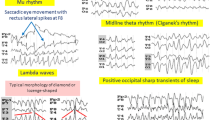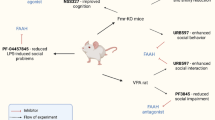Abstract
Chronic ethanol exposure has been described in humans to produce a series of long and short term electrophysiological consequences. Interpretation of the electrophysiological findings in human subjects, however, is made difficult due to concomitant factors, such as nutritional status, premorbid functioning and differences in genetic susceptibility to the effects of ethanol. In the present study, electroencephalograms (EEGs) and auditory event related potentials (ERPs) were utilized to explore the short and longer term effects of chronic ethanol exposure in rats. Rats were continuously exposed to ethanol vapors for a period for 1 month. This treatment produced a mean blood ethanol level of 178 ± 13.86 mg%. EEGs and ERPs were subsequently collected at 10 min, 24 h, and 2 weeks following termination of ethanol exposure. Significant changes in the EEGs and ERPs of these rats could be demonstrated. EEG amplitude increases, as quantified by spectral analysis, were most prominent at the 24h time period, perhaps reflecting a state of “rebound excitability”. EEG responses were normalized in ethanol-treated rats by 2 weeks post-withdrawal. In contrast, reductions in the N1 and P2 amplitudes of the rat ERPs were prominent after chronic ethanol exposure and following 2 weeks withdrawal, suggesting that ethanol may produce some longer term effects on response to ERP stimuli. Taken together, these studies suggest that ethanol may produce differential effects on EEG and ERPs and that this model may provide a useful substrate for the evaluation of the mechanisms underlying the effects of chronic ethanol exposure.
Similar content being viewed by others
References
Altshuler HL, Harlan B, Burch NR, Dossett R, Kendall J, Burton W (1980) Changes in the Rhesus monkey's EEG responses to ethanol during chronic exposure. Pharmacol Biochem Behav 13:223–240
Begleiter H, Coltrera M (1975) Evoked potential changes during ethanol withdrawal in rats. Am J Drug Alcohol Abuse 2:263–268
Begleiter H, Platz A (1972) The effects of alcohol on the central nervous system in humans. In: Kissin B, Begleiter H (eds) The biology of alcoholism. Plenum Press, New York, pp 293–343
Begleiter H, Porjesz B (1977) Persistence of brain hyperexcitability following chronic alcohol exposure in rats. Adv Exp Med Biol 85B:209–222
Begleiter H, Porjesz B (1979) Persistence of a “subacute withdrawal syndrome” following chronic ethanol intake. Drug Alcohol Depend 4:353–357
Begleiter H, Porjesz B, Yerre-Grubstein C (1974) Excitability cycle of somatosensory evoked potentials during experimental alcoholization and withdrawal. Psychopharmacologia 37:15–21
Begleiter H, DeNoble V, Porjesz B (1980a) Protracted brain dysfunction after alcohol withdrawal in monkeys. In: Begleiter H (ed) Biological effects of alcohol. Plenum Press, New York, pp 231–250
Begleiter H, Porjesz B, Tenner M (1980b) Neuroradiological and neurophysiological evidence of brain deficits in chronic alcoholics. Acta Psychiatr Scand 62 [suppl 286]:3–13
Begleiter H, Porjesz B, Bihari B, Kissin B (1984) Event-related brain potentials in boys at risk for alcoholism. Science 225:1493–1495
Bierley RA, Cannon DS, Wehl CK, Dustman RE (1980) Effects of alcohol on visually evoked responses in rats during addiction and withdrawal. Pharmacol Biochem Behav 12:909–915
Bucher T, Redetski H (1951) Eine spezifische photometrische Bestimmung vol Athylakohol auf fermentativen wege. Klin Wochenschr 29:615
Chu NS, Squires KC, Starr A (1978) Auditory brain stem potentials in chronic alcohol intoxication and alcohol withdrawal. Arch Neurol 35:596
Coger RW, Dymond AM, Serafetinides EA, Lowenstam R, Pearson D (1976) Alcoholism: Averaged visual evoked response amplitude-intensity slope and symmetry in withdrawal. Biol Psychiatry 11:435–443
Davis PA, Gibbs FA, Favis H, Jetter WW, Trobridge LS (1941) The effects of alcohol upon the electroencephalogram. Q J Stud Alcohol 1:627–637
Ehlers CL (1988) ERP responses to ethanol and diazepam administration in squirrel monkeys. Alcohol 5:315–320
Ehlers CL (1989) EEG and ERP responses to naloxone and ethanol in monkeys. Prog Neuropsychopharmacol Biol Psychiatry 13:217–228
Ehlers CL, Chaplin RI (1987) Chronic ethanol exposure potentiates the locomotor-activating effects of corticotropin-releasing (CRF) in rats. Regul Pept 19:345–353
Ehlers CL, Havstad JW (1982) Characterization of drug effects on the EEG by power spectral band time series analysis. Psychopharmacol Bull 18:43–47
Ehlers CL, Schuckit MA (1990) EEG fast frequency activity in the sons of alcoholics. Biol Psychiatry 27:631–631
Ehlers CL, Wall TL, Chaplin RI (1989) Auditory long latency ERPs in rats: regional and neurochemical findings. Soc Neurosci Abst 15:1239
Ehlers CL, Wall TL, Chaplin RI (1991a) Long latency event-related potentials in rats: effects of dopaminergic and serotonergic depletions. Pharm Biochem Behav 35:4 (in press)
Ehlers CL, Chaplin RI, Lumeng L, Li TK (1991b) Electrophysiological response to ethanol in P and NP rats. Alcoholism (in press)
Elmasion R, Neville H, Woods D, Schuckit M, Bloom FE (1982) Event-related brain potentials are different in individuals at high and low risk for developing alcoholism. Proc Natl Acad Sci USA 79:4231–4233
Emmerson RY, Dustman RE, Shearer DE, Chamberlain HM (1987) EEG, visually evoked and event related potentials in young abstinent alcoholics. Alcohol 4:241–248
Funkhouser JB, Nagler B, Walke ND (1953) The electroencephalogram of chronic alcoholism. South Med J 46:423–428
Gabrielli WF, Nednick SA, Volavka J, Pollock BE, Schulsinger F, Itil TM (1982) Electroencephalograms in children of alcoholic fathers. Psychophysiology 19[4]:404–407
Goldstein D (1972) Relationship of alcohol dose to intensity of withdrawal signs in mice. J Pharmacol Exp Ther 180:203–215
Halgren E, Squires NK, Wilson CL, Rohrbaugh JW, Babb TL, Crandall PH (1980) Endogenous potentials generated in the human hippocampal formation and amygdala by infrequent events. Science 210:803–805
Hunter BE, Boast CA, Walker DW, Zornetzer SF (1974) Alcohol withdrawal syndrome in rats: neural and behavioral correlates. Pharmacol Biochem Behav p 7.
Isbell H, Fraser HF, Wikler A, Belleville RE, Eisenman AJ (1955) An experimental study of the etiology of “rum fits” and delirium tremors. Q J Stud Alcohol 16:1–33
Jones FW, Homes DS (1976) Alcoholism, alpha production and biofeedback. J Consul Clin Psychol 44:224–228
Naitoh P (1973) The value of electroencephalography in alcoholism. Ann NY Acad Sci 215:303–320
Newman HW (1959) The effect of alcohol on the electroencephalogram. Stanford Med Bull 17:55
Nutt D, Glue P (1986) Monoamines and alcohol. Br J Addict 81:327–338
O'Connor S, Hesselbrock V, Tasman A (1986) Correlates of increased risk for alcoholism in young men. Prog Neuropsychopharmacol Biol Psychiatry 10:211–218
O'Connor S, Hesselbrock V, Tasman A, DePalma N (1987) P3 amplitudes in two distinct tasks are decreased in young men with a history of paternal alcoholism. Alcohol 4:323–330
Patterson BW, Williams HL, McLean GA, Smith LT, Schaeffer KW (1987) Alcoholism and family history of alcoholism. Effects on visual and auditory event-related potentials. Alcohol 4:265–274
Pfefferbaum A, Rosenbloom M, Ford JM (1987) Late event-related potential changes in alcoholism. Alcohol 4:275–281
Polich J (1987) Comparison of P300 from a passive tone sequence paradigm and an active discrimination task. Psychophysiology 24[1]:41–46
Polich J, Fischer A, Starr A (1983) A programmable multi-tone generator. Behav Res Methods Instrum 15[1]:39–41
Porjesz B, Begleiter H (1979) Visual evoked potentials and brain dysfunction in chronic alcoholics. In: Begleiter H (ed) Evoked brain potentials and behavior. Plenum Press, New York, pp 277–302
Porjesz B, Begleiter H (1981) Human evoked brain potentials and alcohol. Alcohol Clin Exp Res 5:304–317
Porjesz B, Begleiter H (1985a) Event related brain potentials to high incentive stimuli in abstinent alcoholics. Alcohol Clin Exp Res 9:190
Porjesz B, Begleiter H (1985b) Human brain electrophysiology and alcoholism. In: Tarter RE, Van Thiel DH (eds) Alcohol and the brain; chronic effects. Plenum Press, New York, pp 139–182
Porjesz B, Begleiter H, Horowitz S (1976) Brain excitability subsequent to alcohol withdrawal in rats In: Ford DH, Clouet DH (eds) Tissue responses to addictive substances. Spectrum, New York, pp 461–469
Porjesz B, Begleiter H, Garozzo R (1980) Visual evoked potentials correlates of information processing deficits in chronic alcoholics. In: Begleiter H (ed) Biological effects of alcohol. Plenum Press, New York, pp 603–623
Riley JN, Walker DW (1978) Morphological alterations in hippocampus after long-term alcohol consumption in mice. Science 201:711–713
Rivier C, Bruhn T, Vale W (1984) Effect of ethanol on the hypothalamic-pituitary-adrenal axis in the rat: role of corticotropin-releasing factor (CRF). J Pharmacol Exp Ther 229[1]:127–131
Rogers J, Wiener SG, Bloom FE (1979) Long-term ethanol administration methods for rats: advantages of inhalation over intubation or liquid diets. Behav Neural Biol 27:466–486
Roth WT (1973) Auditory evoked responses to unpredictable stimuli. Psychophysiology 10:125–137
Squires NK, Squires KC, Hillyard SA (1975) Two varieties of long-latency positive waves evoked by unpredictable auditory stimuli in man. Electroencephalogr Clin Neurophysiol 38:387–401
Walker DW, Zornetzer SF (1974) Alcohol withdrawal in mice: electroencephalographic and behavioral correlates. Electroencephalogr Clin Neurophysiol 36:233–243
Walker DW, Barnes DE, Zornetzer SF (1980) Neuronal loss in hippocampus induced by prolonged ethanol consumption in rat. Science 209:711–713
Walker DW, Hunter BE, Abraham WC (1981) Neuroanatomical and functional deficits subsequent to chronic ethanol administration in animals. Alcoholism: Clin Exp Res 5:267–282
Wall TL, Chaplin RI, Ehlers CL (1989) Does CRF contribute to the cognitive changes in depression? Soc Neurosci Abstr 15:1069
Wikler A, Pescor FT, Graser HF, Isbell H (1956) Electroencephalographic changes associated with chronic alcoholic intoxication and the alcohol abstinence syndrome. Am J Psychiatry 113:106
Wood CG, Allison T, Goff WB, Williamson PD, Spencer DD (1980) On the neural origin of P300 in man. In: Kornhuber HH, Deeke J (eds) Motivation, motor and sensory processes of the brain: electrical potentials, behavior and clinical use. Prog Brain Res Elsevier/North Holland Biomedical Press, Amsterdam, pp 51–56
Author information
Authors and Affiliations
Rights and permissions
About this article
Cite this article
Ehlers, C.L., Chaplin, R.I. EEG and ERP response to chronic ethanol exposure in rats. Psychopharmacology 104, 67–74 (1991). https://doi.org/10.1007/BF02244556
Received:
Revised:
Issue Date:
DOI: https://doi.org/10.1007/BF02244556




